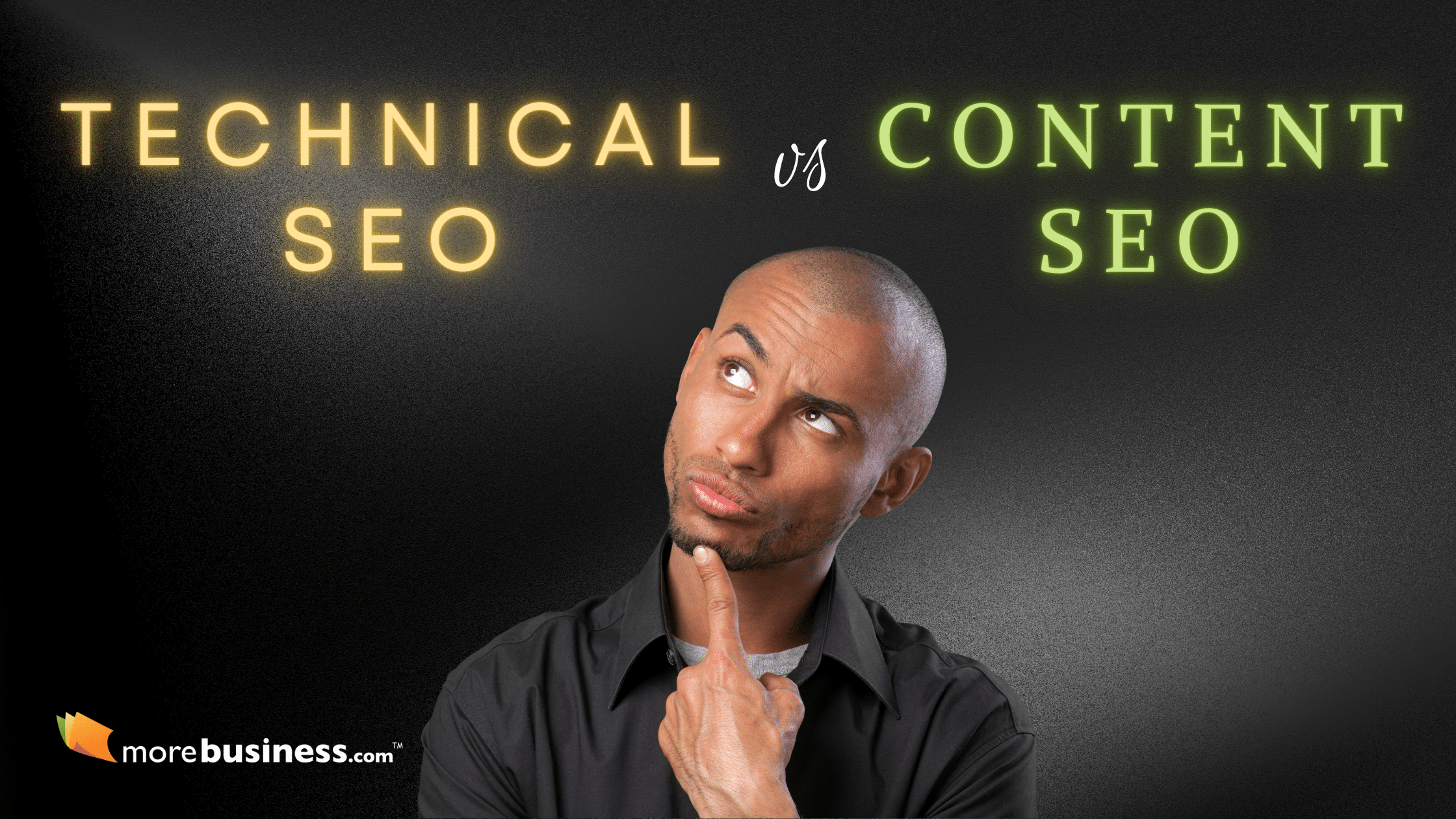Have you heard the terms “content SEO” and “technical SEO” but aren’t quite sure what they mean or why they’re important? You’re not alone! Understanding the difference between content SEO vs technical SEO is essential in growing your online presence and getting Google to send you customers for free.
In this detailed guide, I’ll break down content SEO vs technical SEO and explain how to use each of them to boost your website’s visibility. I’ll also share specific examples that you can tweak to fit your website.
You’ll learn when to use each approach and how they can work together to create a robust SEO strategy that drives traffic and enhances your online presence.
Table of Contents
Content SEO vs Technical SEO
Let’s start by defining what each type of SEO is. I’ll then go into an example for each type, one for product sales and the other for services. This way, you can model the examples and use both technical SEO and content SEO on your website to drive sales.
What is Content SEO?
Content SEO is all about creating, optimizing, and promoting high-quality, engaging, and relevant content on your website. Your main goal is to attract, inform, and retain your target audience while also signaling to search engines, like Google, that your website is valuable and deserves a higher ranking.
As you compare content SEO vs technical SEO, keep in mind Google’s emphasis on E-E-A-T (Experience, Expertise, Authoritativeness, and Trustworthiness) which incorporates Google’s Search Quality Raters Guidelines.
Content SEO Checklist
 These are the 10 most important factors in content SEO.
These are the 10 most important factors in content SEO.
- Keyword research: Identify relevant and high-search-volume keywords that your target audience is using to find content like yours, and incorporate them strategically into your content. This is without question the most important part of a strong content marketing strategy.
- High-quality content: Create informative, engaging, and well-researched content that addresses your audience’s needs and showcases your expertise on the subject matter.
- Readability: Ensure your content is easy to read and understand by using clear language, short sentences, and well-structured paragraphs.
- Meta tags: Write compelling and keyword-optimized meta titles and descriptions that accurately represent your content and encourage users to click on your page in search results.
- Heading tags: Organize your content using proper heading tags (H1, H2, H3, etc.) to make it easily scannable and improve user experience.
- Internal and external linking: Include relevant internal links to other pages on your website and external links to authoritative sources to support your claims and provide additional information to your readers.
- Image optimization: Add descriptive file names and alt tags to your images, and compress them to improve loading times and search engine understanding.
- Content length: Aim for an optimal content length that thoroughly covers the topic and provides valuable insights to your audience without becoming tedious or repetitive.
- Content promotion: Share your content on social media platforms, email newsletters, and other marketing channels to reach a broader audience and increase visibility.
- Regular updates: Continually review and update your content to ensure it remains accurate, relevant, and valuable for your audience, which also signals to search engines that your site is up-to-date.
Unlike technical SEO, Content SEO is all about crafting content that resonates with your audience, showcases your expertise, and answers their questions while persuading them to take action, such as downloading a guide, contacting you for a demo, making a purchase or signing up for your newsletter.
Example of Content SEO for a Consulting Business
 To learn how to structure your content, let’s say you’re running a consulting business. Here’s what you could post in terms of content SEO for your page (we’ll explore technical SEO in a moment):
To learn how to structure your content, let’s say you’re running a consulting business. Here’s what you could post in terms of content SEO for your page (we’ll explore technical SEO in a moment):
- Keyword research: Identify relevant keywords related to management consulting, such as “management consulting tips,” “business process improvement,” or “change management strategies.”
- High-quality content: Create blog posts, case studies, or whitepapers with titles like “10 Essential Tips for Effective Change Management” or “How to Streamline Business Processes for Increased Efficiency.”
- Readability: Write content that is easy to understand, using clear language, concise sentences, and well-structured paragraphs that cater to professionals seeking management consulting advice.
- Meta tags: Craft compelling meta titles and descriptions, such as “Maximize Your Company’s Growth with Expert Management Consulting” and “Discover actionable insights to transform your business with our management consulting services.”
- Heading tags: Organize your content using heading tags like H2 for “Key Components of a Successful Business Strategy” and H3 for “Identifying Growth Opportunities.”
- Internal and external linking: Include internal links to your service pages or other related blog posts and external links to reputable sources like Harvard Business Review or Forbes to support your claims.
- Image optimization: Add images with descriptive file names like “effective-team-collaboration.jpg” and alt tags such as “management consulting team collaborating on a project.” For an article that’s 1500 words long, use about 7 images. You can even add videos to enhance your content.
- Content length: Write comprehensive articles, such as “The Ultimate Guide to Business Process Optimization” or “A Deep Dive into Organizational Change Management,” that cover the topic in-depth without being repetitive.
- Content promotion: Although this isn’t specifically related to content on your page, it can help improve visibility of your content SEO work. Share your content on LinkedIn, join relevant management consulting groups, or create a newsletter to reach potential clients and industry professionals.
- Regular updates: Keep your content fresh by updating statistics, industry trends, or adding new insights to maintain relevancy and showcase your up-to-date expertise in management consulting. And if you use customer examples, stories or case studies, you will have content that nobody else will have. This adds to Google’s helpful content theme of E-E-A-T.
Now let’s turn our attention to the other side of the content SEO vs technical beast.
What is Technical SEO?
 Technical SEO refers to the process of optimizing your website’s infrastructure to ensure that search engines can efficiently crawl, index, and understand your content. By focusing on the technical aspects of your site, you’re laying a strong foundation that allows search engines to access, interpret, and rank your pages more effectively.
Technical SEO refers to the process of optimizing your website’s infrastructure to ensure that search engines can efficiently crawl, index, and understand your content. By focusing on the technical aspects of your site, you’re laying a strong foundation that allows search engines to access, interpret, and rank your pages more effectively.
Technical SEO Checklist
Here’s a quick rundown of the 12 key elements for technical SEO. These are quite different from content SEO as you’ll see.
- Mobile Optimization: Ensure your website is responsive and provides an excellent user experience on various devices, including smartphones and tablets.
- Site Speed: Optimize your website’s loading time by compressing images, minifying CSS and JavaScript files, and using browser caching.
- SSL Certificates and HTTPS: Secure your website by implementing SSL certificates and HTTPS to protect user data and improve search engine trust.
- XML Sitemap: Create and submit an XML sitemap to search engines, providing an easy-to-understand roadmap of your site’s content and structure.
- Crawlability and Indexing: Optimize your site’s architecture and internal linking to facilitate search engine bots in discovering and indexing your content.
- Robots.txt: Use a robots.txt file to guide search engine bots on which pages to crawl or ignore, ensuring proper allocation of crawling resources.
- Structured Data Markup: Implement schema markup to provide search engines with additional context about your content, leading to enhanced search results.
- URL Structure: Create clean, descriptive, and easily readable URLs for better user experience and search engine understanding.
 404 Errors and Redirects: Monitor and fix broken links, implement proper redirects, and create a custom 404 error page to enhance user experience and preserve SEO value. See our examples (and video) of the best 404 pages.
404 Errors and Redirects: Monitor and fix broken links, implement proper redirects, and create a custom 404 error page to enhance user experience and preserve SEO value. See our examples (and video) of the best 404 pages.- Duplicate Content: Identify and resolve duplicate content issues to prevent search engine confusion. Many years ago, duplicate content could result in ranking penalties. This is now considered the duplicate content myth because Google has long since updated their position: they will not deprecate your rank but they may not advance it either. It will not penalize you.
- Site Audit: Regularly perform a comprehensive technical SEO audit to identify and fix any issues that may be affecting your website’s performance and search engine visibility.
- Performance Monitoring: Use tools like Google Search Console and Google Analytics to track and analyze your website’s technical performance and make data-driven improvements.
Ultimately, technical SEO compared to content SEO is all about improving your website’s performance and user experience, which can lead to higher search rankings, more traffic, and better conversions. Now that you have a grasp on what technical SEO is, let’s explore how to apply it in real-life scenarios for selling products and services.
Example of Technical SEO for an Online Store
Let’s say you’re running a product store selling clothing online. By the way, you can change anything in this example to reflect whatever you sell. Here’s what you would do in terms of technical SEO for your page:
- Optimize product page URLs: Create clean, descriptive, and easily readable URLs that include the exact product name or a description with dashes for spaces (e.g., yourstore.com/womens-blue-denim-jacket or yourstore.com/mens-striped-cotton-tshirt).
- Mobile optimization: Design the product page with mobile users in mind, ensuring the headline in an H2 tag displays the product name, followed by a clear image, relevant information such as the description, price, size options, and an easily accessible order button.
 Page speed optimization: Compress product images to reduce file size without losing quality, use minified CSS and JavaScript files to reduce loading time, and implement browser caching to store static resources.
Page speed optimization: Compress product images to reduce file size without losing quality, use minified CSS and JavaScript files to reduce loading time, and implement browser caching to store static resources.- Structured data markup: Add schema markup to specify product properties like name, image, price, and availability, enabling search engines to display rich snippets with star ratings and product details.
- Internal linking: Link to related products or category pages within your website, such as suggesting matching items (e.g., “You may also like: Women’s Black Skinny Jeans” on a denim jacket product page).
- Image optimization: Use descriptive file names like “mens-striped-cotton-tshirt.jpg”, add alt tags that describe the image (e.g., “Men’s Striped Cotton T-Shirt”), and apply image compression techniques to improve loading times.
- Meta tags: Write a unique and engaging meta title like “Stylish Women’s Blue Denim Jacket – YourStore” and a meta description that highlights the product’s key features (e.g., “Upgrade your wardrobe with our chic Women’s Blue Denim Jacket. Perfect for any season, it’s a must-have addition to your closet. Shop now at YourStore!”).
These technical SEO best practices make your product pages well-optimized for both users and search engines, helping your online clothing store achieve better visibility and higher sales.
Comparing Technical SEO vs Content SEO
 While there are other components to SEO, such as link building, let’s recap the key distinctions and commonalities between technical SEO vs content SEO:
While there are other components to SEO, such as link building, let’s recap the key distinctions and commonalities between technical SEO vs content SEO:
Technical SEO Focuses on Website Infrastructure
This aspect of SEO ensures your site loads quickly, is mobile-friendly, and has a well-structured URL, among other factors. By improving your site’s technical foundation, you’ll create a better user experience and make it easier for search engines to crawl and index your content.
Content SEO Emphasizes Content Quality and Relevance
Content SEO is all about creating engaging, informative, and well-structured content that resonates with your target audience. By optimizing your content for relevant keywords, readability, and E-A-T (Expertise, Authoritativeness, and Trustworthiness), you’ll attract and retain users while signaling to search engines that your website is valuable and worth ranking higher.
Both Types of SEO Are Essential for Success
While technical SEO vs content SEO focus on different aspects of your website, they both play a critical role in improving your site’s visibility and performance. By combining the strengths of technical SEO (improving your site’s infrastructure) with the power of content SEO (creating high-quality and relevant content), you’ll create a website that excels in user experience and ranks high in search results.
So, as you work to improve your website’s SEO, remember to pay attention to both content SEO vs technical SEO aspects. By addressing both areas, you’ll ensure a well-rounded and successful approach to search engine optimization.
Overwhelmed? Start With an SEO Coach
 Now that you have a better understanding of the importance of both technical vs content SEO, it’s time to take your website’s optimization to the next level. If you’re feeling overwhelmed or unsure about how to tackle these crucial aspects of SEO, don’t worry – I’m here to help!
Now that you have a better understanding of the importance of both technical vs content SEO, it’s time to take your website’s optimization to the next level. If you’re feeling overwhelmed or unsure about how to tackle these crucial aspects of SEO, don’t worry – I’m here to help!
Google “SEO Coach” and you’ll find me on page 1 of Google close to the top.
Get SEO Coaching →
As an experienced SEO coach, I can guide you through the process of optimizing your website, providing personalized advice and proven strategies to improve your search engine rankings and generating more qualified leads.
 Author: Raj Khera is an SEO Business Coach, a former 3x CEO, and publisher of MoreBusiness.com
Author: Raj Khera is an SEO Business Coach, a former 3x CEO, and publisher of MoreBusiness.com










